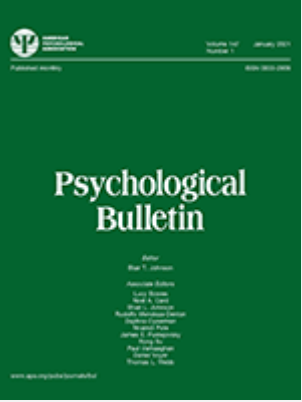关系破裂后男性的自杀倾向:全球数据的系统回顾和荟萃分析。
IF 19.8
1区 心理学
Q1 PSYCHOLOGY
引用次数: 0
摘要
人们对亲密关系破裂与男性自杀之间关系的潜在因素了解甚少。这项系统回顾和荟萃分析调查了哪些男性是最脆弱的,以及导致男性在关系破裂后产生自杀念头、自杀企图和自杀的因素。我们回顾了30个国家(N≥1亿男性)的75项研究。其中29项研究纳入随机效应荟萃分析,其余研究采用叙述性综合。荟萃分析发现,分居/离婚的男性比已婚男性有更大的自杀念头(k = 7;优势比[OR] = 1.64, 95% CI[1.27, 2.13])。离婚男性也有更大的自杀倾向(k = 3;OR = 1.73, 95% CI[1.05, 2.85])和自杀死亡(k = 33;OR = 2.82, 95% CI[2.53, 3.15])高于已婚男性。在关系破裂后不久,自杀的风险似乎最大,因为分居男性的自杀率几乎是离婚男性的两倍(k = 10;Or = 1.96, 95% ci[1.42, 2.71])。男性在关系破裂后的自杀行为还与年龄较小(≤34岁)、未受过高等教育、缺乏就业以及孤独和情绪失调等心理因素有关。研究的局限性包括:源文献的方法差异很大,无法对大多数纳入的研究进行荟萃分析;不一致的人口统计报告禁止对男性亚组进行更详细的荟萃分析;主要关注的是婚姻分居和离婚,相对较少的数据反映了非婚姻关系破裂与自杀的关系。讨论了在关系破裂后预防自杀的机会,以及未来的研究,以解决与男性自杀的关系破裂相互作用的因素方面的知识差距。(PsycInfo Database Record (c) 2025 APA,版权所有)。本文章由计算机程序翻译,如有差异,请以英文原文为准。
Suicidality in men following relationship breakdown: A systematic review and meta-analysis of global data.
Factors underlying the association between intimate relationship breakdown and men's suicidality are poorly understood. This systematic review and meta-analysis examined which men are most vulnerable and the factors underpinning men's suicidal ideation, suicide attempt, and death by suicide following relationship breakdown. We reviewed 75 studies across 30 countries (N ≥ 100 million men). Of these, 29 studies were included in random-effects meta-analyses and the remainder were narratively synthesized. Meta-analyses found separated/divorced men had greater odds of suicidal ideation than married men (k = 7; odds ratio [OR] = 1.64, 95% CI [1.27, 2.13]). Divorced men also had greater odds of suicide attempt (k = 3; OR = 1.73, 95% CI [1.05, 2.85]) and death by suicide (k = 33; OR = 2.82, 95% CI [2.53, 3.15]) than married men. Risk of suicidality appeared greatest in the immediate aftermath of relationship breakdown, as separated men displayed nearly twofold greater odds of suicide than divorced men (k = 10; OR = 1.96, 95% CI [1.42, 2.71]). Men's suicidality following relationship breakdown was also linked to younger age (≤34 years), less than tertiary education, lack of employment, and psychological factors such as loneliness and emotion dysregulation. Study limitations included the following: wide methodological variability in the source literature, precluding meta-analysis of most included studies; inconsistent reporting of demographics prohibiting more detailed meta-analyses within subgroups of men; and a predominant focus on marital separation and divorce, with comparatively little data reflecting nonmarital relationship breakdown in association with suicidality. Opportunities for preventing suicidality following relationship breakdown are discussed, alongside future research to address knowledge gaps regarding factors that interact with relationship breakdown in men's suicidality. (PsycInfo Database Record (c) 2025 APA, all rights reserved).
求助全文
通过发布文献求助,成功后即可免费获取论文全文。
去求助
来源期刊

Psychological bulletin
医学-心理学
CiteScore
33.60
自引率
0.90%
发文量
21
期刊介绍:
Psychological Bulletin publishes syntheses of research in scientific psychology. Research syntheses seek to summarize past research by drawing overall conclusions from many separate investigations that address related or identical hypotheses.
A research synthesis typically presents the authors' assessments:
-of the state of knowledge concerning the relations of interest;
-of critical assessments of the strengths and weaknesses in past research;
-of important issues that research has left unresolved, thereby directing future research so it can yield a maximum amount of new information.
 求助内容:
求助内容: 应助结果提醒方式:
应助结果提醒方式:


